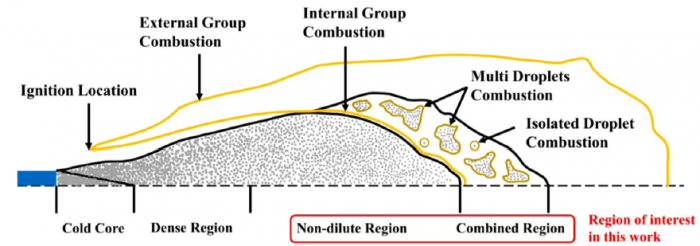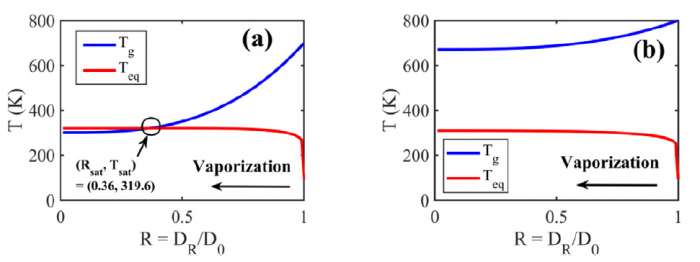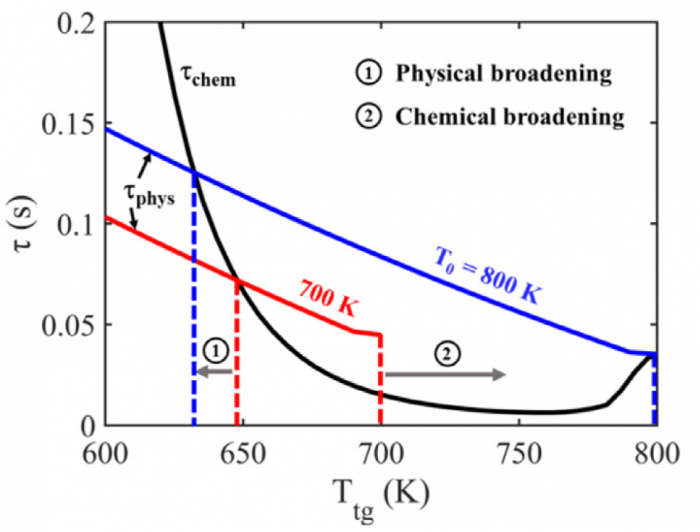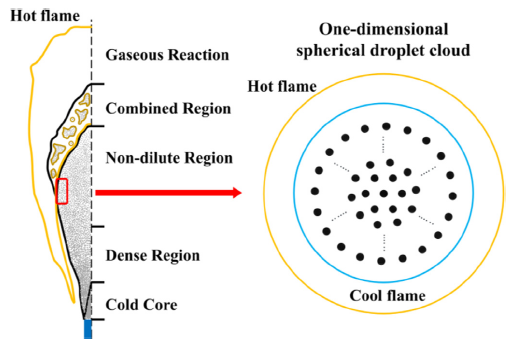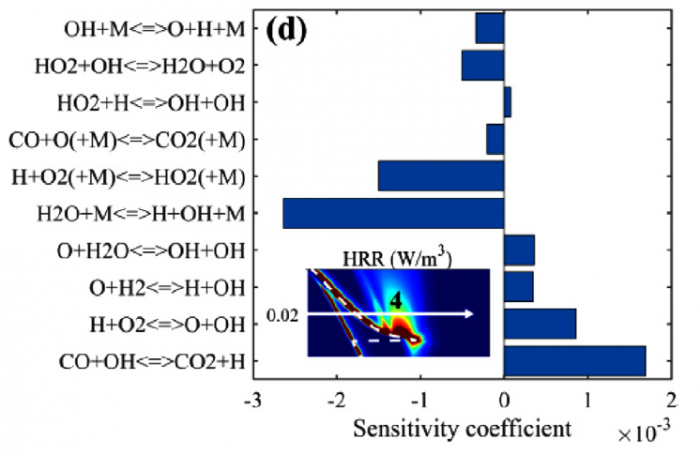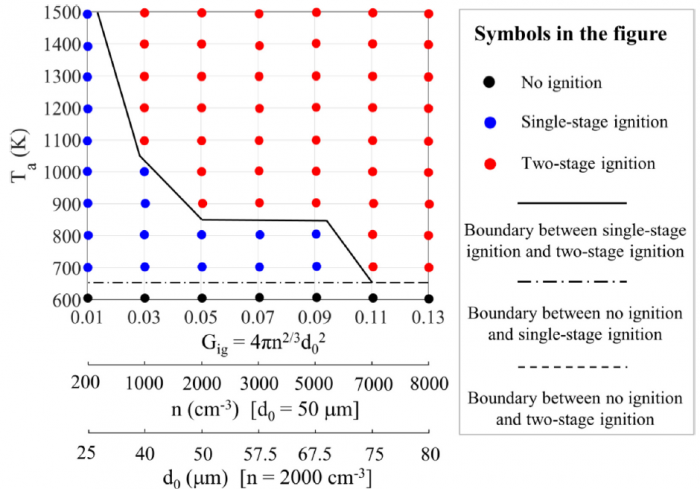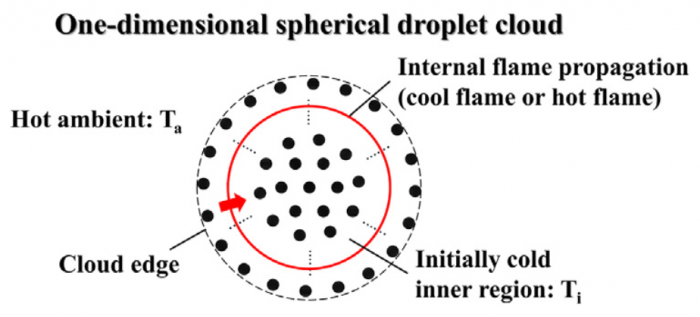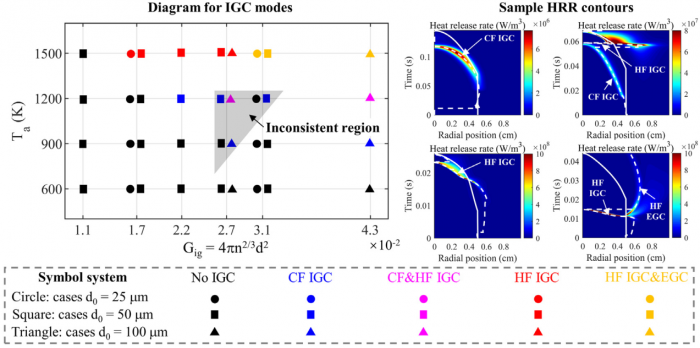H. Zhou, W. Zhang, Y.C. Liu, "A cell model analysis for droplets inside non-dilute n-heptane droplet clouds near autoignition limit", International Journal of Heat and Mass Transfer 175 (2021) 121189.
Vaporization and two-stage autoignition of single droplets inside the droplet clouds were numerically studied using a spherical cell model. We aimed to investigate the behaviors of individual droplets in a moderately hot ambient (600-800 K) under the influence of surrounding droplets at atmospheric pressure. For a given ratio of distance between droplets L and the droplet diameter D0, autoignition only occurs when D0 is above certain critical value. Exemplar cases with L/D0 = 10 were used for detailed discussion as they are found to be near the autoignition limit. For droplets smaller than 400 mm, no ignition occurs and the surrounding gas phase is saturated by fuel vapor before the droplet completely vaporizes. A simple model of final saturation state was established. With this model, it was observed that when the gas phase in the droplet cloud is saturated, the temperature and fuel concentration distributions are insensitive to the distance between droplets. For droplets larger than 500 mm, a variety of autoignition processes including first stage ignition, cool flame burning, second stage ignition, and diffusional extinction are observed. Unlike single isolated droplets, such behaviors are primarily due to heat accumulation and limited supply of oxidizer that pertains to the scenario of non-dilute droplet cloud. Autoignition of individual droplets in a cloud only happens in the region where chemical time scale is smaller than the physical time scale for vaporization and diffusion. The temperature range of autoignition is broadened with increasing initial droplet diameter. Two potential mechanisms were identified for such broadening. Analyses of ‘probable droplet cloud autoignition (PDCA)’ region were found to qualitatively predict the state switch of vaporization, cool flame ignition, and second stage ignition.
-------------------------------------------------------------------------------------------------------
H. Zhou, Y.C. Liu, "External group combustion of droplet clouds under two-stage autoignition conditions", Combustion and Flame 234 (2021) 111689.
The present study aims to extend the understanding of the external group combustion for droplet clouds under two-stage autoignition conditions. First, an exemplar case has been chosen to analyze the two-stage ignition behavior and flame structure. It was found that the fuel vapor transport of the droplet cloud is mainly supported by the thin vaporization layer near the edge of the cloud, which is the dominant factor of the ignition process. The case shows that a typical two-stage ignition includes the following detailed processes: first stage ignition, quasi-steady non-premixed cool flame, second stage ignition, and premixed hot flame. Three possible ignition modes for droplet clouds were identified through parametric studies, i.e. no ignition, single-stage ignition, and two-stage ignition. The transition between these modes is mainly controlled by the competition between chemical reaction and the vaporization of a thin layer of fuel droplets. Phase diagrams of different ignition modes at different ambient temperatures and sub parameters of the group number were presented. The previous group number G = 2πndRc2 demonstrated unsatisfactory prediction in the ignition modes of the droplet clouds. Basing on the vaporization layer feature of the droplet clouds, a new dimensionless group ignition number with much better predictability is first proposed in this work, i.e. Gig = 4πn2/3d2. The physical meaning of Gig is the dimensionless total surface area of droplets within a local layer.
-------------------------------------------------------------------------------------------------------
H. Zhou, Y.C. Liu, "Internal group combustion of dropelt clouds and its transition to external group combustion under two-stage ignition conditions", Proceedings of the Combustion Institute (2022) in press.
The present study is an extension of our prior study on the external group combustion (EGC) of droplet clouds under two-stage autoignition conditions [Zhou and Liu, Combust. Flame 234 (2021) 111689]. Effects of droplet heating and different n-alkane fuel candidates have been further considered. By comparing numerical results from n-heptane and n-dodecane, it was found that the fuel volatility has little effect on the combustion modes of droplet clouds. Among all the computed cases, internal group combustion (IGC) occurs for relatively low value of group ignition number Gig (= 4πn2/3d2, n and d are the droplet number density and diameter, respectively). When Gig further increases, the combustion mode can switch to EGC. IGC modes can be sustained by cool or hot flame. IGC of cool flame exhibits a partial burning structure, while IGC of hot flame is firstly premixed, followed by non-premixed structure. These flame structures were analyzed in details. A regime diagram based on Gig and ambient temperature Ta was developed for all the IGC modes. It was found that for high Ta (1500 K), Gig can be used to predict ICG modes, but for low Ta (900 K) and intermediate Ta (1200 K), additional parameters might be needed for the prediction, especially for the cases when Gig is around 0.03. The inapplicability is due to the strong interaction between droplet behavior (droplet heating and vaporization) and chemical kinetics (low and high temperature reaction) that were not inherent to description of Gig. To clarify the interaction, time scale analysis of these processes was performed for better complementation of the regime diagram characterized by Gig and Ta for various IGC modes.

